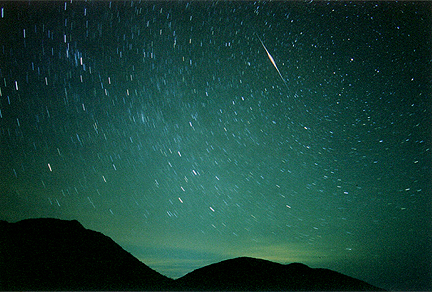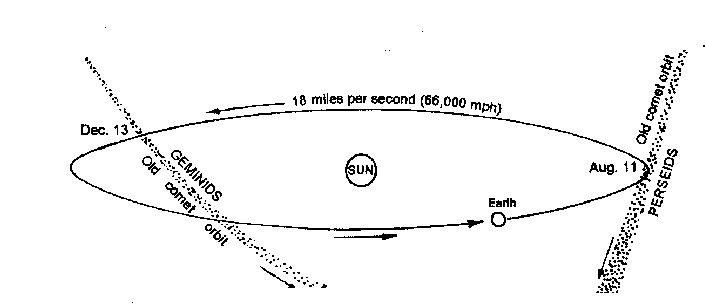

This Leonid meteor was photographed on November 18, 1999, in the western part of the Imperial Valley just north of the Mexican border. The north star (Polaris) is to the right of the meteor. R. Dunakin.
Does your heart skip a beat every time you see a falling star? Mine does. No doubt this happens to many people even though we all know that they are not stars at all but meteors. Space is full of junk. Much of it is dust and small pieces of rock left over from a comet's visit. As a comet gets closer and closer to the sun, its outer layer of ice melts leaving the dust and small chunks of rock in its orbit. Those beautiful falling stars are really particles usually no bigger than a grain of sand. The friction caused by that particle of sand's sailing through our atmosphere at 70 kilometers an hour usually causes the meteor to burn up. The earth is hit with a great deal of this space junk. Usually it burns up before we even see it. Those that don't are our falling stars.
"Every day the Earth runs into many of these particles. But, before the particle can reach the surface, its high velocity creates friction with Earth's upper atmosphere and the particle burns up. The meteoroid that was minding is own business until it got run over by a bus is, for a brief moment as it's burning up, is a meteor. If it reaches the ground, a meteor is called a meteorite." Your Guide to the Sky by Rick Shaffer page 84
Fireballs
On occasion you can witness a truly spectacular event called a fireball. See one once and you will never forget it. I have seen several fireballs and I am always left breathless. Fireballs are meteors with a fiery tail that are extremely bright as they plow though the atmosphere. A fireball can be as bright or brighter than Venus which is the third brightest object in the sky. They can even cast a slight shadow. If that isn't exciting enough sometimes a fireball explodes with sound effects. All of the fireballs I have ever seen leave a long trail that can last for several seconds after the fireball is gone. Many of the books I have recommend that you look at that trail through binoculars as it dissipates.
I still like to recall the first time a member of the Astronuts, my astronomy club, saw a fireball. He called me excited about what he had seen. He then called all of the other members in the club. Fireballs are indeed that spectacular.
Meteor Showers
On any given night you can see at least six meteors, but several times a year you can witness a meteor shower. The debris left over by comets causes meteor showers. Comets have a specific orbit around our sun. A comet comes from why out beyond Jupiter, sheding its outer layer as it orbits our sun and leaving dust and dirt littered along its orbit before it disappears back into the far reaches of space. Sometimes a comet breaks up completely. The debris from that comet still follows its original orbit. When the earth crosses the orbit a comet, it passes through that debris and we have a meteor shower.

The stray meteors that can be seen any night are called sporadic and they come form all different points in the sky. All of the meteors in a meteor shower, however, seem to radiate from one specific place on the celestial dome. That place is called the meteor showers radiate. These showers happen several times a year and are named after the constellation they seem to radiate from. For example, the Leonid shower seems to radiate from the constellation Leo.
"The seeming divergence of shower meteors from a common point is easily explained. The meteoroids producing a meteor shower are members of a swarm; they are all traveling together in closely spaced parallel orbits about the sun. When the earth passes through such a swarm, it is struck by many meteoroids, all approaching it from the same direction. As we, on the ground, look toward the direction from which the particles are coming, they all seem to diverge from it. Similarly, if we look along railway tracks, those tracks, although parallel to each other, seem to diverge away from a point in the distance." Your Guide to the Sky by Rick Shaffer
"The highlight for meteor observers during any year are the nights when meteor showers are active. Although each shower is somewhat different, they normally last for several nights with a peak of activity occurring on a specific date. Chances of observing meteors are greatly increased on the night a shower is active as rates can range to 50 or more per hour depending upon the shower. "
From NAMN (North American Meteor Network) page on Meteors.
Meteor showers are best observed on dark moonless nights as a quarter moon or full moon can play havoc with observing. Go out anytime after midnight for the best viewing. The early morning hours are the best. Get a lounge chair and sit with your feet facing the radiate. Some people like to take a blanket and lie on the ground. Dress warmly for it will get colder than you think. I always have my classical music. I think the boys in the Astronuts need a little Beethoven with their meteors.
|
|
|
|
|
|
|
|
|
|
|
|
|
|
|
|
|
|
|
|
|
|
|
|
|
|
|
|
|
|
|
|
|
|
|
|
|
|
|
|
|
|
|
|
|
|
|
|
|
|
|
|
|
|
|
|
|
|
|
|
|
|
|
|
|
|
|
|
|
|
|
|
* Leonid
This is a very special meteor shower. Most of the time it is very unimpressive, but once every 33 to 32 years it is a blow out. During those years the Leonids are not a meteor shower but a meteor storm. November 17 of 1966 the people in the southwestern United States say not 6 meteors per hour but 100 meteors per second. That is 60,000 an hour! Many people were convinced that the end of the world was at hand. This wasn't the only time that happened. In 1833 the meteor storm was so heavy that the meteors fell like snow flakes. Leonids are also known for fireballs.
Why is this exciting? Ladies and gentlemen, this is the year!! Such a storm was predicted for last year and this year. Last year was not 100 per second, but it was very spectacular. My astronomy club saw 246 an hour with six fire balls last November 17. It was worth staying out in the cold. We can't wait for this year. We are already praying for clear weather. Don't miss it.
>
![]()


 View Guestbook
View Guestbook